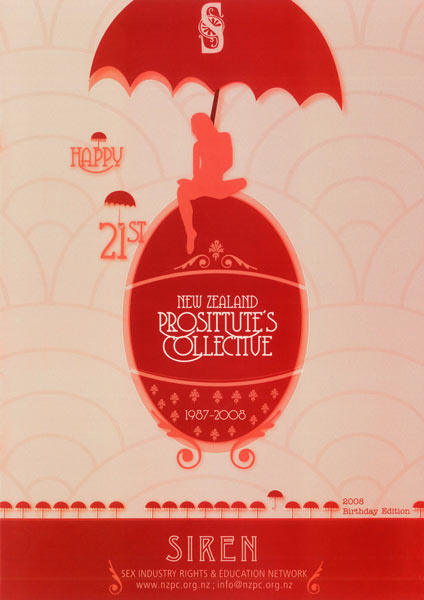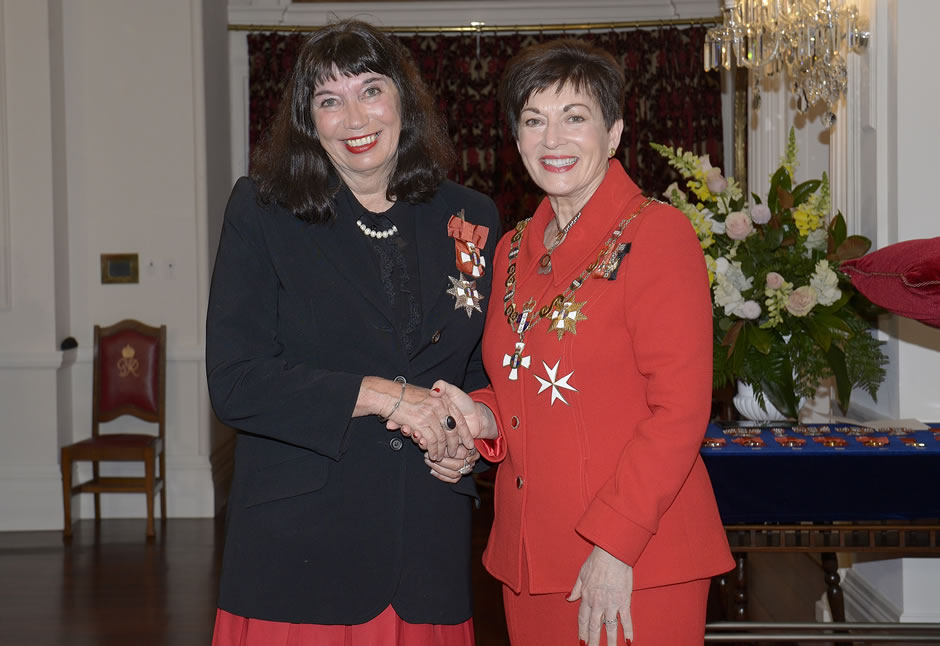This essay written by Jan Jordan was first published in Women Together: a History of Women's Organisations in New Zealand in 1993. It was updated by Jan Jordan in 2018.
1987 – 1993
Workers in the sex industry were one of the latest groups to organise themselves formally into collectives. Stigmatised and harassed from without, often isolated and divided from within, their highly marginalised position in society made unionisation difficult. The New Zealand Prostitutes' Collective (NZPC) emerged toward the end of 1987 from a series of informal discussions held by sex workers in Wellington, who felt strongly the need for an organisation to address their specific concerns.
The principal aims of NZPC were to prevent the transmission of HIV/AIDS into the sex industry; to work for a legal and social order which neither criminalised nor discriminated against sex workers; and to play an advocacy role in relation to sex workers, for example by supporting their efforts for improved working conditions.
To achieve these aims, the collective established outreach programmes in four New Zealand centres. Community bases were formed in Auckland, Wellington and Dunedin; in 1993 another was planned for Christchurch, where a telephone contact service was operating. There was also a night-time drop-in centre in Auckland located next to Karangahape Road, the country's largest 'red light' district.
NZPC estimated that there were at least 8500 sex industry workers in New Zealand in the early 1990s, working on the streets, in parlours, as escorts, in hotels, and from private clubs and homes. Although most were women, transsexuals, transvestites and male escorts also worked within the industry and were becoming increasingly active within the collective. NZPC membership reflected the diversity of sex workers in terms of age, class, ethnicity, sexual preference, religious background and educational levels.

New Zealand Prostitutes' Collective
This issue of Siren, celebrating the 21st anniversary of the New Zealand Prostitutes' Collective, appeared in 2008, the last year in which the magazine was published.
In 1988 the Department of Health contracted NZPC to work in the area of HIV/AIDS prevention, and the bulk of the collective's funding then came from the department. With the equivalent of only 1.5 paid full-time workers, however, much of the collective's service delivery was dependent on its approximately 40 volunteers. The services provided included peer education, through programmes promoting awareness of HIV/AIDS; distribution of condoms and lubricants, to encourage safe sex practices; a regular magazine, Siren (Sex Industry Rights and Education Network), with a print run of 2000; a supportive social environment for workers; and referral services to sympathetic doctors and other agencies. NZPC networked with other community AIDS organisations and with sex worker rights groups overseas, and also provided a forum for discussion between sex workers, government departments and community agencies.
In 1989 NZPC presented a submission on the Crimes Bill to the Parliamentary Committee on Justice and Law Reform, and continued to promote legislative reform. It held that the legal double standard, which censured the prostitute while condoning the client, forced sex workers to live in constant fear of arrest and conviction, causing a major disruption to their livelihood. It saw decriminalising prostitution as going some way toward ending the discrimination experienced by sex workers and reducing their relative powerlessness within the industry.
The collective also saw the discriminatory legislation then in force as a major impediment to AIDS education and outreach programmes: 'If AIDS is to be kept out of the sex industry, then the sex industry will have to be brought out of hiding, and not driven further underground.' [1] Because the effective prevention of HIV/AIDS in the sex industry depended on improving the legal status of sex workers, this was the primary focus for NZPC in the 1990s.
Jan Jordan
1994 – 2018
In 1993, the NZPC had existed for only five years. There were many, including some of those involved in establishing it, who doubted it would survive even that long, such was the opposition initially encountered. Even the supposedly simple task of having their phone number listed in the telephone directory had been a battle, with Telecom objecting to having the word ‘prostitutes’ printed in their phone book.
Twenty-five years on, it was difficult to recall the early fragility of this organisation and the strength needed to ensure its survival. By 2018 NZPC employed 18 people, mostly part-time, supplemented by volunteers and specialist contract workers. There were community bases in five New Zealand cities – Auckland, Wellington, Christchurch, Dunedin, and Tauranga – all of which provided support and information services for sex workers across the various sectors of this diverse industry. The range of services available included free sexual health checks, legal and financial information, support with managing drug and alcohol issues, provision of condoms and other safe sex products, advice on such topics as managing clients or exiting the industry, and drop-in centres offering community support. Fundamentally it remained an organisation run by sex workers for sex workers.
The legal climate in 2018 was vastly different from that which existed when NZPC was established, a change attributable largely to its own successful campaign for law reform. The National Co-ordinator of NZPC from its inception, Catherine Healy, became a familiar face during the 1990s as she fronted this campaign, at times weathering hostile opposition from some quarters. More significantly, she and others within NZPC successfully attracted support from a wide and diverse range of women’s groups, community organisations, academics and politicians, all of whom took up the cause of arguing the importance of recognising and protecting the human rights of sex workers. This support base included the Young Women’s Christian Association, the Maori Women’s Welfare League, the Business and Professional Women’s Federation, and the National Council of Women.
As noted above, support for decriminalising the sex industry was largely built upon opposition to ways in which existing laws perpetuated a gross double standard. This resulted in the women who worked in the sex industry risking conviction for providing sexual services to men whose identities and access were protected. The essentially illegal status of sex workers also made them vulnerable to coercive and exploitative practices, with few opportunities for legal redress should they be harmed or otherwise offended against. These factors, combined with the negative stigma surrounding prostitution, also posed barriers for any workers wanting to exit the sex industry.
In 2003, after Labour politician Tim Barnett sponsored the Prostitution Reform Bill through Parliament, the final vote saw it narrowly pass into law, making New Zealand the first country in the world to decriminalise sex work. This legislation was unique in seeking to uphold the human and employment rights of sex workers, and included provisions designed to protect them from coercion and exploitation.
The Prostitution Reform Act was actively monitored during its first five years of operation by the Prostitution Law Review Committee, an eclectic group that included sex workers and was chaired by a retired Assistant Police Commissioner. The observations and consultations of this committee were important, given the extreme fears voiced by those opposed to the law change that it would result in massive increases in the number of sex workers and cause widespread corruption and immorality. The PLRC’s final 2008 report was reassuring in confirming no such eventualities, instead outlining some of the benefits associated with the Act’s impact in reducing the stigma and vulnerability of those involved in the sex industry:
The Committee concludes that the PRA has had a marked effect in safeguarding the right of sex workers to refuse particular clients and practices, chiefly by empowering sex workers through removing the illegality of their work. [2]

Catherine Healey, left, shown with Governor-General Dame Patsy Reddy, after her investiture as a Dame Companion of the New Zealand Order of Merit for services to the rights of sex workers, in Sept 2018.
By 2018 NZPC had a significant international profile and was networked globally with many sex worker rights’ organisations. It was widely recognised as unique in having successfully built and maintained solidarity across all sectors of an industry often divided amongst itself, and was celebrated widely for its successful lobbying for radical law reform. International scholars were studying the collective’s success, seeking to understand how and why it had managed to achieve what many still believed to be impossible – a legal environment within which sex workers’ rights are protected and their ability to refuse client or employer demands is upheld. In June 2018 international headlines were made when, in the Queen’s Birthday Honours list, Catherine Healy was made a Dame, a form of recognition that this seasoned battler found both humbling and moving. It had been a long, hard journey, but her tenacity infused that of NZPC overall, and ensured that gradually the early stigma was replaced by admiration for its ongoing advocacy for sex workers’ rights. An organisation founded by a small group of women had taken less than twenty years to challenge longstanding hypocrisy and change the laws of the nation.
Jan Jordan
Notes
[1] Catherine Healy, founding member, NZPC, Speech delivered in the Beehive Theatrette, Wellington, 27 August 1992.
[2] Ministry of Justice, 2008, p.14.
Unpublished sources
New Zealand Prostitutes' Collective records, 1987–1992, NZPC National Office, Wellington.
NZPC website, http://www.nzpc.org.nz/
Published sources
Barnett, Tim, Catherine Healy, Anna Reed and Calum Bennachie, ‘Lobbying for decriminalisation’, in Gillian Abel, Lisa Fitzgerald, and Catherine Healy (eds), Taking the Crime Out of Sex Work: New Zealand sex workers fight for decriminalisation, Policy Press, Bristol, 2010, pp. 57–73.
Healy, Catherine, Calum Bennachie and Anna Reed, ‘History of the New Zealand Prostitutes’ Collective’, in Gillian Abel, Lisa Fitzgerald, and Catherine Healy (eds), Taking the Crime Out of Sex Work: New Zealand sex workers fight for decriminalisation, Policy Press, Bristol, 2010, pp. 45–55.
Jordan, Jan, ‘”Of whalers, diggers and soiled doves”: A history of the sex industry in New Zealand’, in Gillian Abel, Lisa Fitzgerald, and Catherine Healy (eds), Taking the Crime Out of Sex Work: New Zealand sex workers fight for decriminalisation, Policy Press, Bristol, 2010, pp. 25–44.
Manson, Bess, ‘Dame Catherine Healy: “brought in from the cold” after career advocating for sex workers’, Stuff, 4 June 2018. https://www.stuff.co.nz/national/104330042/dame-catherine-healy-brought-in-from-the-cold-after-career-advocating-for-sex-workers
Ministry of Justice, Report of the Prostitution Law Review Committee on the operation of the Prostitution Reform Act 2003, May 2008
New Zealand Prostitutes' Collective, 'Off Our Backs and on to Our Political Feet!', in Jan Jordan, Working Girls: Women in the New Zealand Sex Industry Talk to Jan Jordan, Penguin, Auckland, 1991, pp. 271–74
Radacic, Ivana, New Zealand Prostitutes’ Collective: An example of a successful policy actor, Social Sciences, Vol. 6 No. 2, 2017.
Siren, Magazine of the New Zealand Prostitutes' Collective, 1988–2008.

Community contributions